University Finance Report: Accounting and Capital Structure Analysis
VerifiedAdded on 2020/04/07
|10
|1313
|375
Report
AI Summary
This report provides a detailed analysis of the capital structure of APN Outdoor Group, focusing on its debt-to-equity ratio, weighted average cost of capital (WACC), and key financial ratios such as cash ratio, quick ratio, current ratio, interest coverage, and long-term debt-to-assets ratio. The report examines capital budgeting techniques, including Net Present Value (NPV) and Profitability Index (PI), to evaluate the viability of projects. It compares APN's performance with its competitor, Ooh Media, highlighting changes in capital structure over the years. The conclusion summarizes findings related to equity, debentures, and shareholder returns. References to relevant academic sources support the analysis.
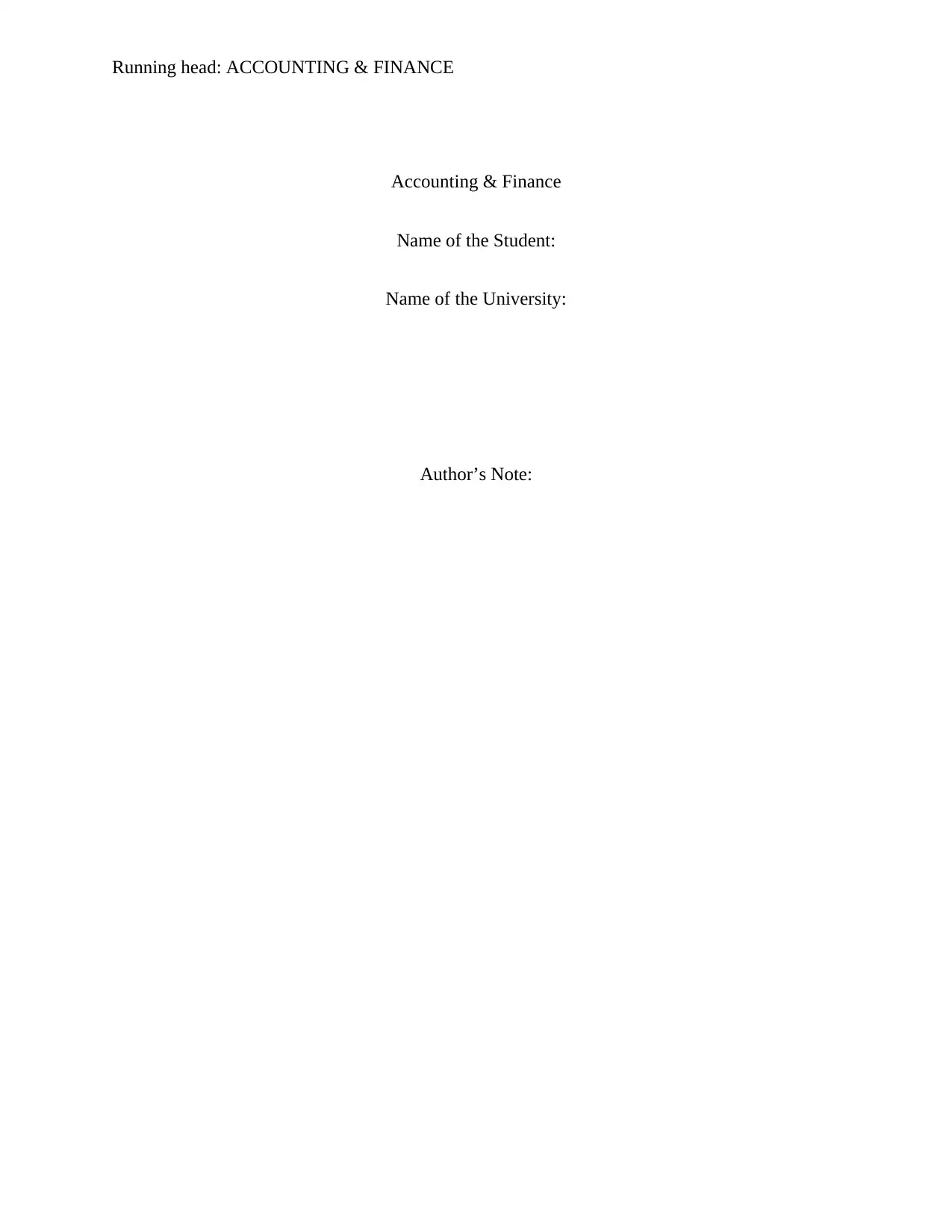
Running head: ACCOUNTING & FINANCE
Accounting & Finance
Name of the Student:
Name of the University:
Author’s Note:
Accounting & Finance
Name of the Student:
Name of the University:
Author’s Note:
Paraphrase This Document
Need a fresh take? Get an instant paraphrase of this document with our AI Paraphraser

1ACCOUNTING & FINANCE
Table of Contents
Answer to Part A:............................................................................................................................2
Requirement 1:.............................................................................................................................2
Requirement 2:.............................................................................................................................4
Requirement 3:.............................................................................................................................4
Answer to PART B:.........................................................................................................................5
Introduction:................................................................................................................................5
Analysis of APN’s capital structure:...........................................................................................5
Computation of After-Tax WACC:.............................................................................................6
Analysis of financial ratio of APN:.............................................................................................6
APN outdoor group and its competitor performance:.................................................................6
Capital structure of APN Outdoor group:....................................................................................7
Conclusion:..................................................................................................................................7
References........................................................................................................................................8
Table of Contents
Answer to Part A:............................................................................................................................2
Requirement 1:.............................................................................................................................2
Requirement 2:.............................................................................................................................4
Requirement 3:.............................................................................................................................4
Answer to PART B:.........................................................................................................................5
Introduction:................................................................................................................................5
Analysis of APN’s capital structure:...........................................................................................5
Computation of After-Tax WACC:.............................................................................................6
Analysis of financial ratio of APN:.............................................................................................6
APN outdoor group and its competitor performance:.................................................................6
Capital structure of APN Outdoor group:....................................................................................7
Conclusion:..................................................................................................................................7
References........................................................................................................................................8
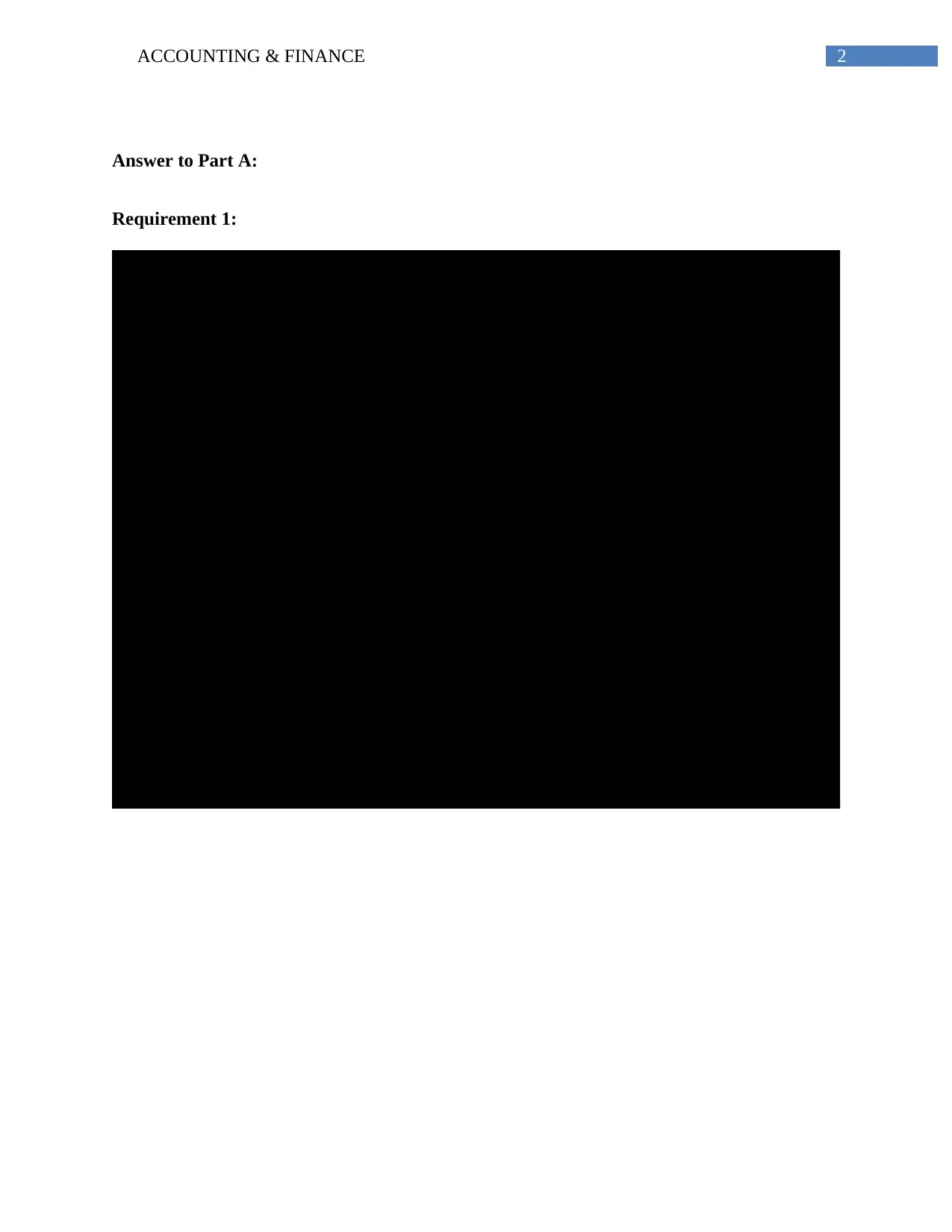
2ACCOUNTING & FINANCE
Answer to Part A:
Requirement 1:
Particulars 0 1 2 3 4 5 6 7 8
Initial Investment ($1,650,000)
Annual Cash Flow:
Incremental Revene $1,445,000 $1,589,500 $1,748,450 $1,923,295 $2,115,625 $2,327,187 $2,559,906 $2,815,896
Staff Cost ($900,000) ($954,000) ($1,011,240) ($1,071,914) ($1,136,229) ($1,204,403) ($1,276,667) ($1,353,267)
Material Costs ($210,000) ($222,600) ($235,956) ($250,113) ($265,120) ($281,027) ($297,889) ($315,762)
Marketing Costs ($46,000) ($48,760) ($51,686) ($54,787) ($58,074) ($61,558) ($65,252) ($69,167)
Other Costs ($25,000) ($26,500) ($28,090) ($29,775) ($31,562) ($33,456) ($35,463) ($37,591)
Depreciation of Lab ($206,250) ($206,250) ($206,250) ($206,250) ($206,250) ($206,250) ($206,250) ($206,250)
Net Profit before Tax $57,750 $131,390 $215,228 $310,455 $418,389 $540,493 $678,385 $833,859
Less: Tax on Profit ($17,325) ($39,417) ($64,569) ($93,137) ($125,517) ($162,148) ($203,515) ($250,158)
Net Profit after Tax $40,425 $91,973 $150,660 $217,319 $292,872 $378,345 $474,869 $583,701
Add: Depreciation $206,250 $206,250 $206,250 $206,250 $206,250 $206,250 $206,250 $206,250
Annual After-Tax Cash Flow $246,675 $298,223 $356,910 $423,569 $499,122 $584,595 $681,119 $789,951
Salvage Value $100,000
Net Annual Cash Flow ($1,650,000) $246,675 $298,223 $356,910 $423,569 $499,122 $584,595 $681,119 $889,951
Cumulative Cash Flow ($1,650,000) ($1,403,325) ($1,105,102) ($748,192) ($324,624) $174,499 $759,094 $1,440,213 $2,330,164
Payback Period
Required Rate of Return 16% 16% 16% 16% 16% 16% 16% 16% 16%
Discounted Cash Flow ($1,650,000) $212,651 $221,628 $228,657 $233,933 $237,639 $239,942 $241,000 $271,458
Cumulative Discounted Cash Flow ($1,650,000) ($1,437,349) ($1,215,721) ($987,064) ($753,131) ($515,492) ($275,550) ($34,549) $236,908
Discounted Payback period
Net Present Value
Profitability Index
4.65
7.13
$236,908
114.36%
Period
Capital Budgeting for Base-Case:
Answer to Part A:
Requirement 1:
Particulars 0 1 2 3 4 5 6 7 8
Initial Investment ($1,650,000)
Annual Cash Flow:
Incremental Revene $1,445,000 $1,589,500 $1,748,450 $1,923,295 $2,115,625 $2,327,187 $2,559,906 $2,815,896
Staff Cost ($900,000) ($954,000) ($1,011,240) ($1,071,914) ($1,136,229) ($1,204,403) ($1,276,667) ($1,353,267)
Material Costs ($210,000) ($222,600) ($235,956) ($250,113) ($265,120) ($281,027) ($297,889) ($315,762)
Marketing Costs ($46,000) ($48,760) ($51,686) ($54,787) ($58,074) ($61,558) ($65,252) ($69,167)
Other Costs ($25,000) ($26,500) ($28,090) ($29,775) ($31,562) ($33,456) ($35,463) ($37,591)
Depreciation of Lab ($206,250) ($206,250) ($206,250) ($206,250) ($206,250) ($206,250) ($206,250) ($206,250)
Net Profit before Tax $57,750 $131,390 $215,228 $310,455 $418,389 $540,493 $678,385 $833,859
Less: Tax on Profit ($17,325) ($39,417) ($64,569) ($93,137) ($125,517) ($162,148) ($203,515) ($250,158)
Net Profit after Tax $40,425 $91,973 $150,660 $217,319 $292,872 $378,345 $474,869 $583,701
Add: Depreciation $206,250 $206,250 $206,250 $206,250 $206,250 $206,250 $206,250 $206,250
Annual After-Tax Cash Flow $246,675 $298,223 $356,910 $423,569 $499,122 $584,595 $681,119 $789,951
Salvage Value $100,000
Net Annual Cash Flow ($1,650,000) $246,675 $298,223 $356,910 $423,569 $499,122 $584,595 $681,119 $889,951
Cumulative Cash Flow ($1,650,000) ($1,403,325) ($1,105,102) ($748,192) ($324,624) $174,499 $759,094 $1,440,213 $2,330,164
Payback Period
Required Rate of Return 16% 16% 16% 16% 16% 16% 16% 16% 16%
Discounted Cash Flow ($1,650,000) $212,651 $221,628 $228,657 $233,933 $237,639 $239,942 $241,000 $271,458
Cumulative Discounted Cash Flow ($1,650,000) ($1,437,349) ($1,215,721) ($987,064) ($753,131) ($515,492) ($275,550) ($34,549) $236,908
Discounted Payback period
Net Present Value
Profitability Index
4.65
7.13
$236,908
114.36%
Period
Capital Budgeting for Base-Case:
⊘ This is a preview!⊘
Do you want full access?
Subscribe today to unlock all pages.

Trusted by 1+ million students worldwide
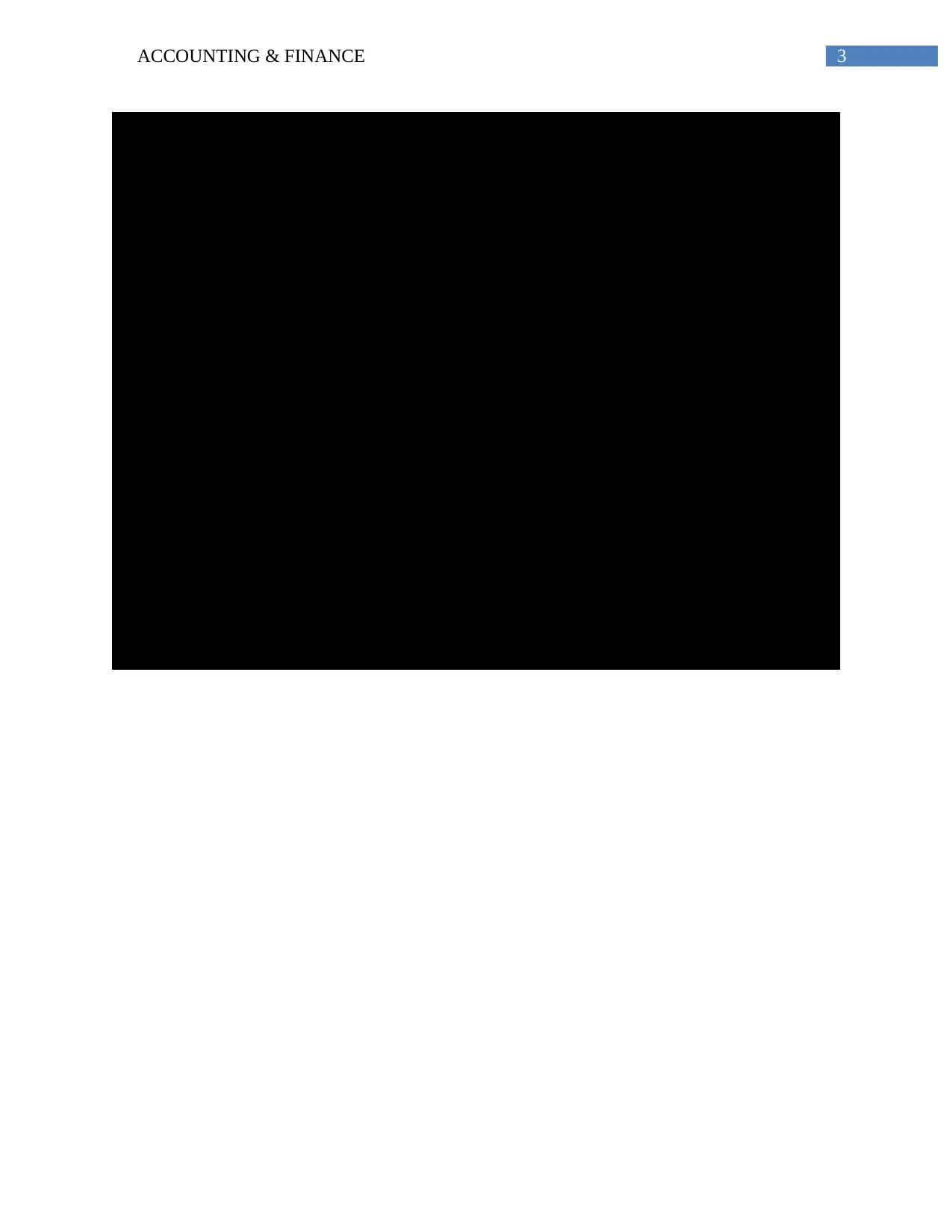
3ACCOUNTING & FINANCE
Particulars 0 1 2 3 4 5 6 7 8
Initial Investment ($1,650,000)
Annual Cash Flow:
Incremental Revene $1,445,000 $1,531,700 $1,623,602 $1,721,018 $1,824,279 $1,933,736 $2,049,760 $2,172,746
Staff Cost ($900,000) ($990,000) ($1,089,000) ($1,197,900) ($1,317,690) ($1,449,459) ($1,594,405) ($1,753,845)
Material Costs ($210,000) ($231,000) ($254,100) ($279,510) ($307,461) ($338,207) ($372,028) ($409,231)
Marketing Costs ($46,000) ($50,600) ($55,660) ($61,226) ($67,349) ($74,083) ($81,492) ($89,641)
Other Costs ($25,000) ($27,500) ($30,250) ($33,275) ($36,603) ($40,263) ($44,289) ($48,718)
Depreciation of Lab ($206,250) ($206,250) ($206,250) ($206,250) ($206,250) ($206,250) ($206,250) ($206,250)
Net Profit before Tax $57,750 $26,350 ($11,658) ($57,143) ($111,073) ($174,526) ($248,703) ($334,939)
Less: Tax on Profit ($17,325) ($7,905) $3,497 $17,143 $33,322 $52,358 $74,611 $100,482
Net Profit after Tax $40,425 $18,445 ($8,161) ($40,000) ($77,751) ($122,168) ($174,092) ($234,457)
Add: Depreciation $206,250 $206,250 $206,250 $206,250 $206,250 $206,250 $206,250 $206,250
Annual After-Tax Cash Flow $246,675 $224,695 $198,089 $166,250 $128,499 $84,082 $32,158 ($28,207)
Salvage Value $100,000
Net Annual Cash Flow ($1,650,000) $246,675 $224,695 $198,089 $166,250 $128,499 $84,082 $32,158 $71,793
Cumulative Cash Flow ($1,650,000) ($1,403,325) ($1,178,630) ($980,541) ($814,291) ($685,792) ($601,710) ($569,552) ($497,760)
Payback Period
Required Rate of Return 16% 16% 16% 16% 16% 16% 16% 16% 16%
Discounted Cash Flow ($1,650,000) $212,651 $166,985 $126,907 $91,818 $61,180 $34,511 $11,378 $21,899
Cumulative Discounted Cash Flow ($1,650,000) ($1,437,349) ($1,270,364) ($1,143,457) ($1,051,638) ($990,458) ($955,948) ($944,569) ($922,671)
Discounted Payback period
Net Present Value
Profitability Index
Capital Budgeting for Worst-Case:
Period
10.34
50.13
($922,671)
44.08%
Particulars 0 1 2 3 4 5 6 7 8
Initial Investment ($1,650,000)
Annual Cash Flow:
Incremental Revene $1,445,000 $1,531,700 $1,623,602 $1,721,018 $1,824,279 $1,933,736 $2,049,760 $2,172,746
Staff Cost ($900,000) ($990,000) ($1,089,000) ($1,197,900) ($1,317,690) ($1,449,459) ($1,594,405) ($1,753,845)
Material Costs ($210,000) ($231,000) ($254,100) ($279,510) ($307,461) ($338,207) ($372,028) ($409,231)
Marketing Costs ($46,000) ($50,600) ($55,660) ($61,226) ($67,349) ($74,083) ($81,492) ($89,641)
Other Costs ($25,000) ($27,500) ($30,250) ($33,275) ($36,603) ($40,263) ($44,289) ($48,718)
Depreciation of Lab ($206,250) ($206,250) ($206,250) ($206,250) ($206,250) ($206,250) ($206,250) ($206,250)
Net Profit before Tax $57,750 $26,350 ($11,658) ($57,143) ($111,073) ($174,526) ($248,703) ($334,939)
Less: Tax on Profit ($17,325) ($7,905) $3,497 $17,143 $33,322 $52,358 $74,611 $100,482
Net Profit after Tax $40,425 $18,445 ($8,161) ($40,000) ($77,751) ($122,168) ($174,092) ($234,457)
Add: Depreciation $206,250 $206,250 $206,250 $206,250 $206,250 $206,250 $206,250 $206,250
Annual After-Tax Cash Flow $246,675 $224,695 $198,089 $166,250 $128,499 $84,082 $32,158 ($28,207)
Salvage Value $100,000
Net Annual Cash Flow ($1,650,000) $246,675 $224,695 $198,089 $166,250 $128,499 $84,082 $32,158 $71,793
Cumulative Cash Flow ($1,650,000) ($1,403,325) ($1,178,630) ($980,541) ($814,291) ($685,792) ($601,710) ($569,552) ($497,760)
Payback Period
Required Rate of Return 16% 16% 16% 16% 16% 16% 16% 16% 16%
Discounted Cash Flow ($1,650,000) $212,651 $166,985 $126,907 $91,818 $61,180 $34,511 $11,378 $21,899
Cumulative Discounted Cash Flow ($1,650,000) ($1,437,349) ($1,270,364) ($1,143,457) ($1,051,638) ($990,458) ($955,948) ($944,569) ($922,671)
Discounted Payback period
Net Present Value
Profitability Index
Capital Budgeting for Worst-Case:
Period
10.34
50.13
($922,671)
44.08%
Paraphrase This Document
Need a fresh take? Get an instant paraphrase of this document with our AI Paraphraser

4ACCOUNTING & FINANCE
Particulars 0 1 2 3 4 5 6 7 8
Initial Investment ($1,650,000)
Annual Cash Flow:
Incremental Revene $1,445,000 $1,661,750 $1,911,013 $2,197,664 $2,527,314 $2,906,411 $3,342,373 $3,843,729
Staff Cost ($900,000) ($927,000) ($954,810) ($983,454) ($1,012,958) ($1,043,347) ($1,074,647) ($1,106,886)
Material Costs ($210,000) ($216,300) ($222,789) ($229,473) ($236,357) ($243,448) ($250,751) ($258,274)
Marketing Costs ($46,000) ($47,380) ($48,801) ($50,265) ($51,773) ($53,327) ($54,926) ($56,574)
Other Costs ($25,000) ($25,750) ($26,523) ($27,318) ($28,138) ($28,982) ($29,851) ($30,747)
Depreciation of Lab ($206,250) ($206,250) ($206,250) ($206,250) ($206,250) ($206,250) ($206,250) ($206,250)
Net Profit before Tax $57,750 $239,070 $451,840 $700,904 $991,838 $1,331,058 $1,725,947 $2,184,998
Less: Tax on Profit ($17,325) ($71,721) ($135,552) ($210,271) ($297,551) ($399,318) ($517,784) ($655,499)
Net Profit after Tax $40,425 $167,349 $316,288 $490,633 $694,287 $931,741 $1,208,163 $1,529,498
Add: Depreciation $206,250 $206,250 $206,250 $206,250 $206,250 $206,250 $206,250 $206,250
Annual After-Tax Cash Flow $246,675 $373,599 $522,538 $696,883 $900,537 $1,137,991 $1,414,413 $1,735,748
Salvage Value $100,000
Net Annual Cash Flow ($1,650,000) $246,675 $373,599 $522,538 $696,883 $900,537 $1,137,991 $1,414,413 $1,835,748
Cumulative Cash Flow ($1,650,000) ($1,403,325) ($1,029,726) ($507,188) $189,694 $1,090,231 $2,228,222 $3,642,635 $5,478,383
Payback Period
Required Rate of Return 16% 16% 16% 16% 16% 16% 16% 16% 16%
Discounted Cash Flow ($1,650,000) $212,651 $277,645 $334,768 $384,882 $428,757 $467,080 $500,461 $559,950
Cumulative Discounted Cash Flow ($1,650,000) ($1,437,349) ($1,159,704) ($824,936) ($440,054) ($11,297) $455,782 $956,244 $1,516,194
Discounted Payback period
Net Present Value
Profitability Index
Capital Budgeting for Best-Case:
Period
3.79
5.29
$1,516,194
191.89%
Requirement 2:
It has been discerned that the capital budgeting techniques may consider various
techniques from the projected cases. Based on the net value technique the future cash flow has
been predicted. Some of the other methods have been seen in terms of ARR to estimate the risk
of project (Hall & Westerman, 2013).
Requirement 3:
The table has been able to discern that the NPV can be positive and the PI is set at
191.89%. The positive NPV value has indicated the fact that the project is seen to be viable in
nature and consider the associated investments. The cost benefit ration aspect of the project has
Particulars 0 1 2 3 4 5 6 7 8
Initial Investment ($1,650,000)
Annual Cash Flow:
Incremental Revene $1,445,000 $1,661,750 $1,911,013 $2,197,664 $2,527,314 $2,906,411 $3,342,373 $3,843,729
Staff Cost ($900,000) ($927,000) ($954,810) ($983,454) ($1,012,958) ($1,043,347) ($1,074,647) ($1,106,886)
Material Costs ($210,000) ($216,300) ($222,789) ($229,473) ($236,357) ($243,448) ($250,751) ($258,274)
Marketing Costs ($46,000) ($47,380) ($48,801) ($50,265) ($51,773) ($53,327) ($54,926) ($56,574)
Other Costs ($25,000) ($25,750) ($26,523) ($27,318) ($28,138) ($28,982) ($29,851) ($30,747)
Depreciation of Lab ($206,250) ($206,250) ($206,250) ($206,250) ($206,250) ($206,250) ($206,250) ($206,250)
Net Profit before Tax $57,750 $239,070 $451,840 $700,904 $991,838 $1,331,058 $1,725,947 $2,184,998
Less: Tax on Profit ($17,325) ($71,721) ($135,552) ($210,271) ($297,551) ($399,318) ($517,784) ($655,499)
Net Profit after Tax $40,425 $167,349 $316,288 $490,633 $694,287 $931,741 $1,208,163 $1,529,498
Add: Depreciation $206,250 $206,250 $206,250 $206,250 $206,250 $206,250 $206,250 $206,250
Annual After-Tax Cash Flow $246,675 $373,599 $522,538 $696,883 $900,537 $1,137,991 $1,414,413 $1,735,748
Salvage Value $100,000
Net Annual Cash Flow ($1,650,000) $246,675 $373,599 $522,538 $696,883 $900,537 $1,137,991 $1,414,413 $1,835,748
Cumulative Cash Flow ($1,650,000) ($1,403,325) ($1,029,726) ($507,188) $189,694 $1,090,231 $2,228,222 $3,642,635 $5,478,383
Payback Period
Required Rate of Return 16% 16% 16% 16% 16% 16% 16% 16% 16%
Discounted Cash Flow ($1,650,000) $212,651 $277,645 $334,768 $384,882 $428,757 $467,080 $500,461 $559,950
Cumulative Discounted Cash Flow ($1,650,000) ($1,437,349) ($1,159,704) ($824,936) ($440,054) ($11,297) $455,782 $956,244 $1,516,194
Discounted Payback period
Net Present Value
Profitability Index
Capital Budgeting for Best-Case:
Period
3.79
5.29
$1,516,194
191.89%
Requirement 2:
It has been discerned that the capital budgeting techniques may consider various
techniques from the projected cases. Based on the net value technique the future cash flow has
been predicted. Some of the other methods have been seen in terms of ARR to estimate the risk
of project (Hall & Westerman, 2013).
Requirement 3:
The table has been able to discern that the NPV can be positive and the PI is set at
191.89%. The positive NPV value has indicated the fact that the project is seen to be viable in
nature and consider the associated investments. The cost benefit ration aspect of the project has
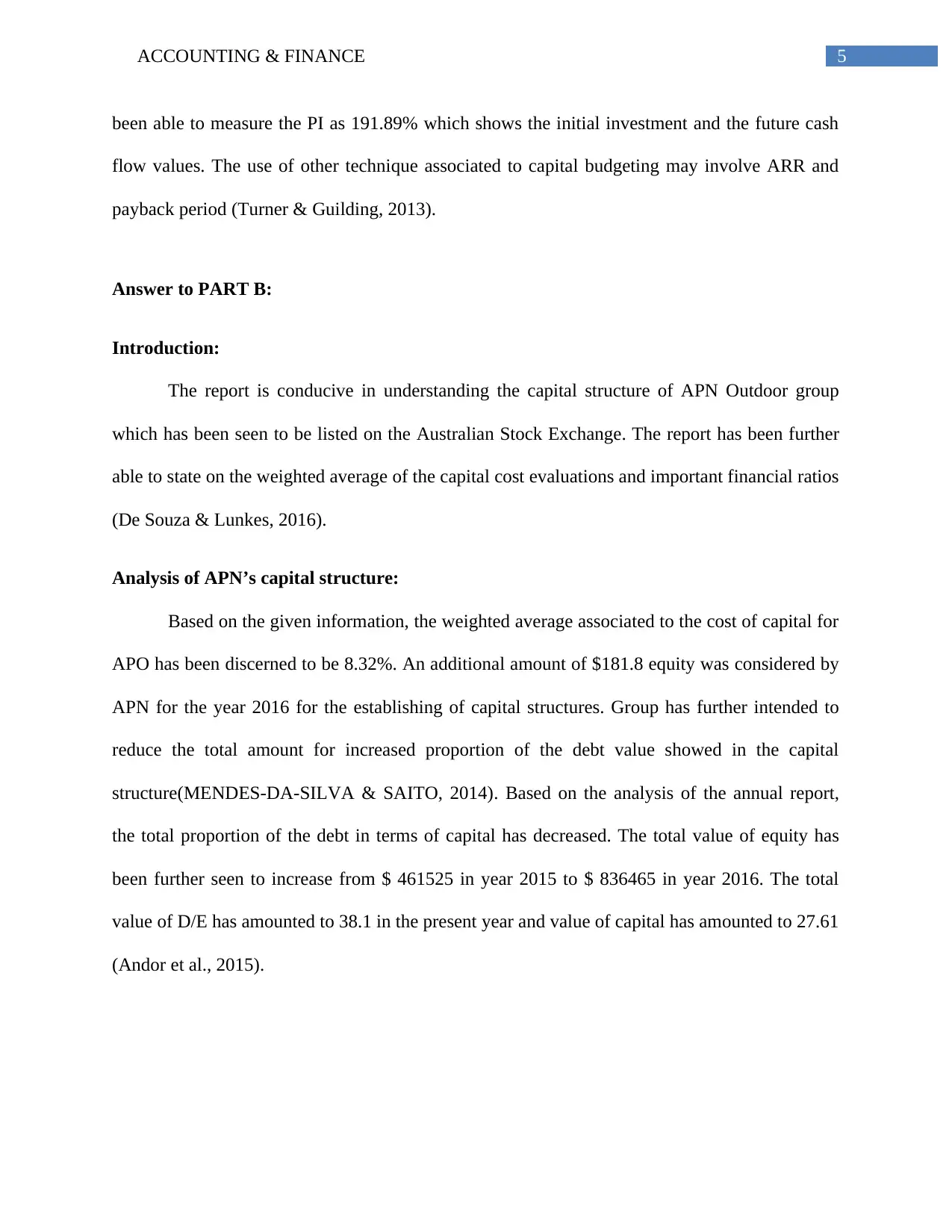
5ACCOUNTING & FINANCE
been able to measure the PI as 191.89% which shows the initial investment and the future cash
flow values. The use of other technique associated to capital budgeting may involve ARR and
payback period (Turner & Guilding, 2013).
Answer to PART B:
Introduction:
The report is conducive in understanding the capital structure of APN Outdoor group
which has been seen to be listed on the Australian Stock Exchange. The report has been further
able to state on the weighted average of the capital cost evaluations and important financial ratios
(De Souza & Lunkes, 2016).
Analysis of APN’s capital structure:
Based on the given information, the weighted average associated to the cost of capital for
APO has been discerned to be 8.32%. An additional amount of $181.8 equity was considered by
APN for the year 2016 for the establishing of capital structures. Group has further intended to
reduce the total amount for increased proportion of the debt value showed in the capital
structure(MENDES-DA-SILVA & SAITO, 2014). Based on the analysis of the annual report,
the total proportion of the debt in terms of capital has decreased. The total value of equity has
been further seen to increase from $ 461525 in year 2015 to $ 836465 in year 2016. The total
value of D/E has amounted to 38.1 in the present year and value of capital has amounted to 27.61
(Andor et al., 2015).
been able to measure the PI as 191.89% which shows the initial investment and the future cash
flow values. The use of other technique associated to capital budgeting may involve ARR and
payback period (Turner & Guilding, 2013).
Answer to PART B:
Introduction:
The report is conducive in understanding the capital structure of APN Outdoor group
which has been seen to be listed on the Australian Stock Exchange. The report has been further
able to state on the weighted average of the capital cost evaluations and important financial ratios
(De Souza & Lunkes, 2016).
Analysis of APN’s capital structure:
Based on the given information, the weighted average associated to the cost of capital for
APO has been discerned to be 8.32%. An additional amount of $181.8 equity was considered by
APN for the year 2016 for the establishing of capital structures. Group has further intended to
reduce the total amount for increased proportion of the debt value showed in the capital
structure(MENDES-DA-SILVA & SAITO, 2014). Based on the analysis of the annual report,
the total proportion of the debt in terms of capital has decreased. The total value of equity has
been further seen to increase from $ 461525 in year 2015 to $ 836465 in year 2016. The total
value of D/E has amounted to 38.1 in the present year and value of capital has amounted to 27.61
(Andor et al., 2015).
⊘ This is a preview!⊘
Do you want full access?
Subscribe today to unlock all pages.

Trusted by 1+ million students worldwide

6ACCOUNTING & FINANCE
Computation of After-Tax WACC:
Particulars Amount Weightage Return Rate
Weighted
Return
Total Equity Capital $836,465 83.83% 8.38% 7.03%
Total Debt Capital $161,309 16.17% 11.42% 1.85%
Tax Rate 30%
After-Tax Weighted Average Cost
of Capital 8.32%
Computation of After-Tax Weighted Avergae Cost of Capital:
Analysis of financial ratio of APN:
The total net operating value of the cash flow has been seen to be discerned to be reduced
during last three FY. In the last three years the total earnings of the group has been seen to be
lacking by 19% by the target and the strategic activities of the current year has been recognized
as 0.29. The decrease in the earnings has been further discerned with 44.4 in year 2015 to 31.4 in
year 2016. In 2017 the P/E ratio has been considered as 16.92 (Dellavigna & Pollet, 2013).
The cash ratio of APN has been discerned as 0.38, quick ratio as 1.89 and current ratio
as 1.90. The total amount of the interest coverage has been seen to be 25.96 and long term D/A
as 0.23 (MENDES-DA-SILVA & SAITO, 2014).
APN outdoor group and its competitor performance:
Ooh Media is identified as one of the main competitors of APN Outdoor group. The
capital structure of the company has been identified as the mix of both borrowings and equity.
The total value for the equity capital increased for the organization. Henceforth, the capital
structure of APN has been seen to be consisting of both debt and equity in the capital structure
composition (Johnson et al., 2013). The capital structure for APN Outdoor group has
Computation of After-Tax WACC:
Particulars Amount Weightage Return Rate
Weighted
Return
Total Equity Capital $836,465 83.83% 8.38% 7.03%
Total Debt Capital $161,309 16.17% 11.42% 1.85%
Tax Rate 30%
After-Tax Weighted Average Cost
of Capital 8.32%
Computation of After-Tax Weighted Avergae Cost of Capital:
Analysis of financial ratio of APN:
The total net operating value of the cash flow has been seen to be discerned to be reduced
during last three FY. In the last three years the total earnings of the group has been seen to be
lacking by 19% by the target and the strategic activities of the current year has been recognized
as 0.29. The decrease in the earnings has been further discerned with 44.4 in year 2015 to 31.4 in
year 2016. In 2017 the P/E ratio has been considered as 16.92 (Dellavigna & Pollet, 2013).
The cash ratio of APN has been discerned as 0.38, quick ratio as 1.89 and current ratio
as 1.90. The total amount of the interest coverage has been seen to be 25.96 and long term D/A
as 0.23 (MENDES-DA-SILVA & SAITO, 2014).
APN outdoor group and its competitor performance:
Ooh Media is identified as one of the main competitors of APN Outdoor group. The
capital structure of the company has been identified as the mix of both borrowings and equity.
The total value for the equity capital increased for the organization. Henceforth, the capital
structure of APN has been seen to be consisting of both debt and equity in the capital structure
composition (Johnson et al., 2013). The capital structure for APN Outdoor group has
Paraphrase This Document
Need a fresh take? Get an instant paraphrase of this document with our AI Paraphraser
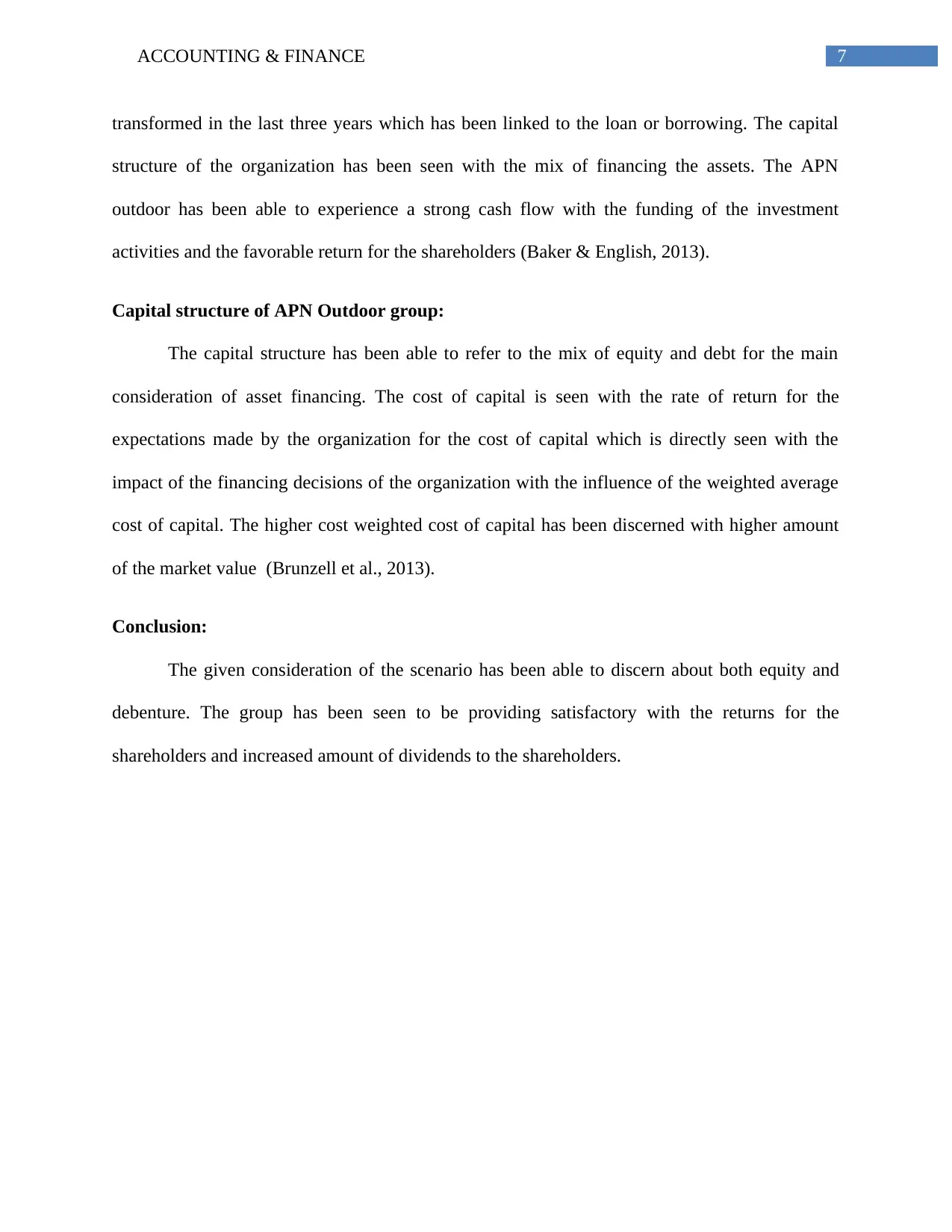
7ACCOUNTING & FINANCE
transformed in the last three years which has been linked to the loan or borrowing. The capital
structure of the organization has been seen with the mix of financing the assets. The APN
outdoor has been able to experience a strong cash flow with the funding of the investment
activities and the favorable return for the shareholders (Baker & English, 2013).
Capital structure of APN Outdoor group:
The capital structure has been able to refer to the mix of equity and debt for the main
consideration of asset financing. The cost of capital is seen with the rate of return for the
expectations made by the organization for the cost of capital which is directly seen with the
impact of the financing decisions of the organization with the influence of the weighted average
cost of capital. The higher cost weighted cost of capital has been discerned with higher amount
of the market value (Brunzell et al., 2013).
Conclusion:
The given consideration of the scenario has been able to discern about both equity and
debenture. The group has been seen to be providing satisfactory with the returns for the
shareholders and increased amount of dividends to the shareholders.
transformed in the last three years which has been linked to the loan or borrowing. The capital
structure of the organization has been seen with the mix of financing the assets. The APN
outdoor has been able to experience a strong cash flow with the funding of the investment
activities and the favorable return for the shareholders (Baker & English, 2013).
Capital structure of APN Outdoor group:
The capital structure has been able to refer to the mix of equity and debt for the main
consideration of asset financing. The cost of capital is seen with the rate of return for the
expectations made by the organization for the cost of capital which is directly seen with the
impact of the financing decisions of the organization with the influence of the weighted average
cost of capital. The higher cost weighted cost of capital has been discerned with higher amount
of the market value (Brunzell et al., 2013).
Conclusion:
The given consideration of the scenario has been able to discern about both equity and
debenture. The group has been seen to be providing satisfactory with the returns for the
shareholders and increased amount of dividends to the shareholders.
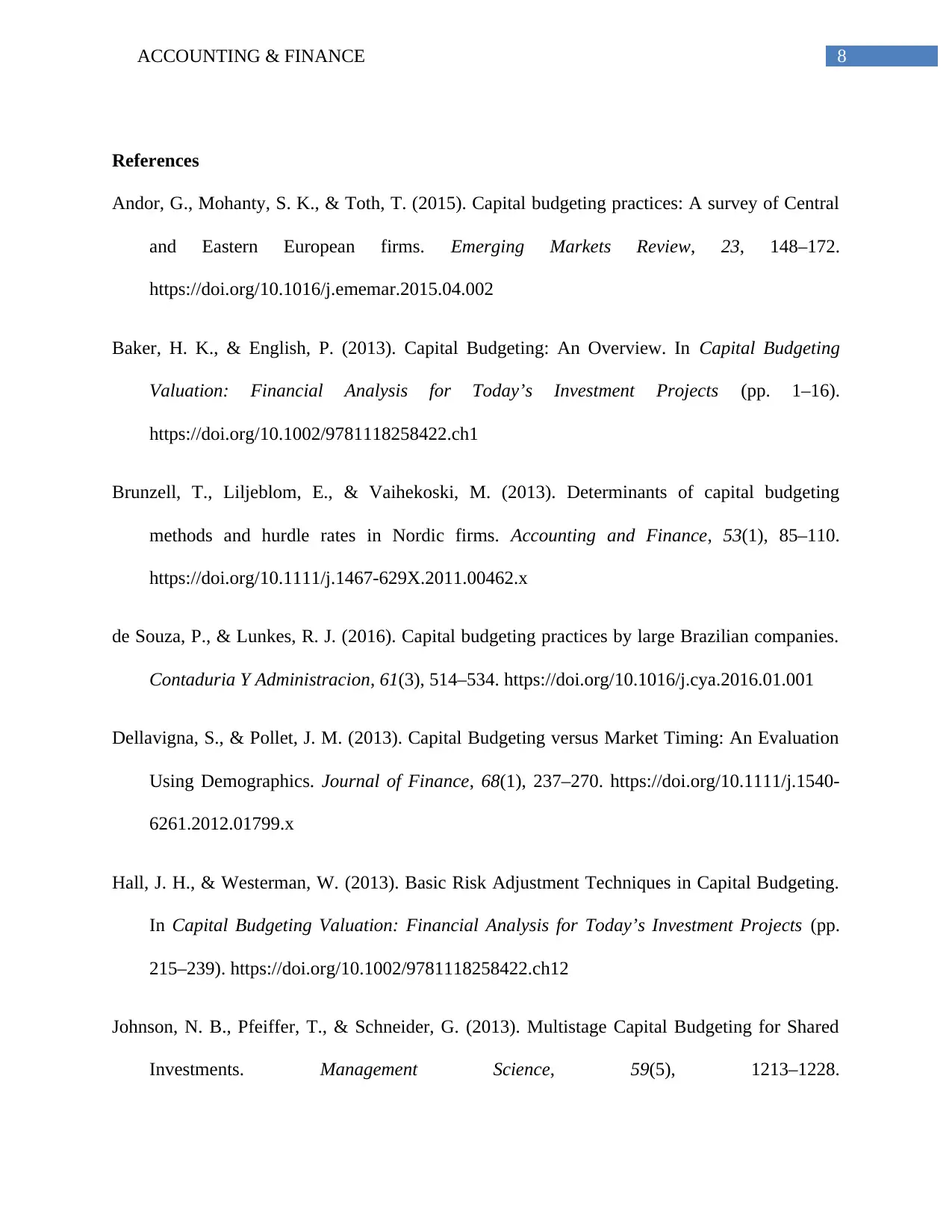
8ACCOUNTING & FINANCE
References
Andor, G., Mohanty, S. K., & Toth, T. (2015). Capital budgeting practices: A survey of Central
and Eastern European firms. Emerging Markets Review, 23, 148–172.
https://doi.org/10.1016/j.ememar.2015.04.002
Baker, H. K., & English, P. (2013). Capital Budgeting: An Overview. In Capital Budgeting
Valuation: Financial Analysis for Today’s Investment Projects (pp. 1–16).
https://doi.org/10.1002/9781118258422.ch1
Brunzell, T., Liljeblom, E., & Vaihekoski, M. (2013). Determinants of capital budgeting
methods and hurdle rates in Nordic firms. Accounting and Finance, 53(1), 85–110.
https://doi.org/10.1111/j.1467-629X.2011.00462.x
de Souza, P., & Lunkes, R. J. (2016). Capital budgeting practices by large Brazilian companies.
Contaduria Y Administracion, 61(3), 514–534. https://doi.org/10.1016/j.cya.2016.01.001
Dellavigna, S., & Pollet, J. M. (2013). Capital Budgeting versus Market Timing: An Evaluation
Using Demographics. Journal of Finance, 68(1), 237–270. https://doi.org/10.1111/j.1540-
6261.2012.01799.x
Hall, J. H., & Westerman, W. (2013). Basic Risk Adjustment Techniques in Capital Budgeting.
In Capital Budgeting Valuation: Financial Analysis for Today’s Investment Projects (pp.
215–239). https://doi.org/10.1002/9781118258422.ch12
Johnson, N. B., Pfeiffer, T., & Schneider, G. (2013). Multistage Capital Budgeting for Shared
Investments. Management Science, 59(5), 1213–1228.
References
Andor, G., Mohanty, S. K., & Toth, T. (2015). Capital budgeting practices: A survey of Central
and Eastern European firms. Emerging Markets Review, 23, 148–172.
https://doi.org/10.1016/j.ememar.2015.04.002
Baker, H. K., & English, P. (2013). Capital Budgeting: An Overview. In Capital Budgeting
Valuation: Financial Analysis for Today’s Investment Projects (pp. 1–16).
https://doi.org/10.1002/9781118258422.ch1
Brunzell, T., Liljeblom, E., & Vaihekoski, M. (2013). Determinants of capital budgeting
methods and hurdle rates in Nordic firms. Accounting and Finance, 53(1), 85–110.
https://doi.org/10.1111/j.1467-629X.2011.00462.x
de Souza, P., & Lunkes, R. J. (2016). Capital budgeting practices by large Brazilian companies.
Contaduria Y Administracion, 61(3), 514–534. https://doi.org/10.1016/j.cya.2016.01.001
Dellavigna, S., & Pollet, J. M. (2013). Capital Budgeting versus Market Timing: An Evaluation
Using Demographics. Journal of Finance, 68(1), 237–270. https://doi.org/10.1111/j.1540-
6261.2012.01799.x
Hall, J. H., & Westerman, W. (2013). Basic Risk Adjustment Techniques in Capital Budgeting.
In Capital Budgeting Valuation: Financial Analysis for Today’s Investment Projects (pp.
215–239). https://doi.org/10.1002/9781118258422.ch12
Johnson, N. B., Pfeiffer, T., & Schneider, G. (2013). Multistage Capital Budgeting for Shared
Investments. Management Science, 59(5), 1213–1228.
⊘ This is a preview!⊘
Do you want full access?
Subscribe today to unlock all pages.

Trusted by 1+ million students worldwide
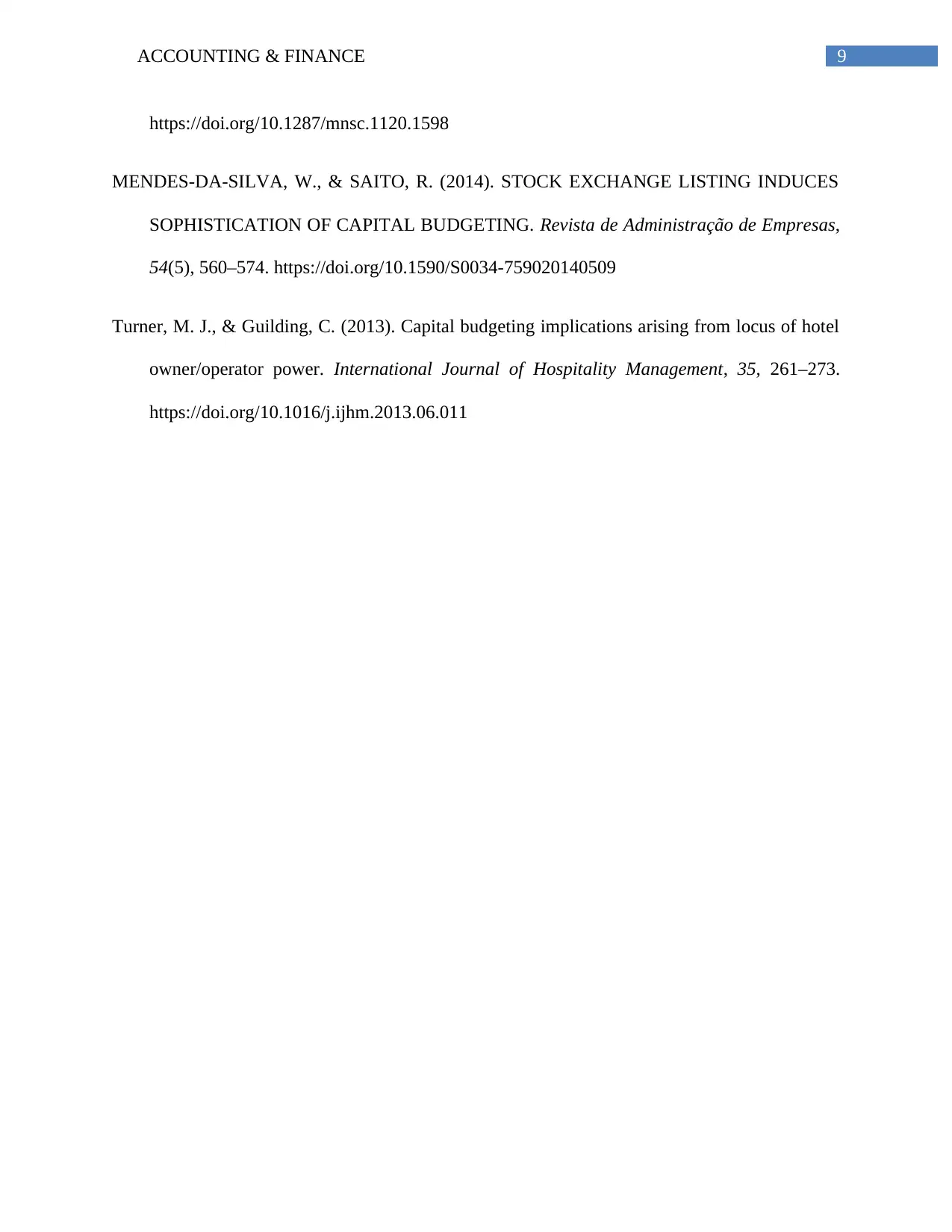
9ACCOUNTING & FINANCE
https://doi.org/10.1287/mnsc.1120.1598
MENDES-DA-SILVA, W., & SAITO, R. (2014). STOCK EXCHANGE LISTING INDUCES
SOPHISTICATION OF CAPITAL BUDGETING. Revista de Administração de Empresas,
54(5), 560–574. https://doi.org/10.1590/S0034-759020140509
Turner, M. J., & Guilding, C. (2013). Capital budgeting implications arising from locus of hotel
owner/operator power. International Journal of Hospitality Management, 35, 261–273.
https://doi.org/10.1016/j.ijhm.2013.06.011
https://doi.org/10.1287/mnsc.1120.1598
MENDES-DA-SILVA, W., & SAITO, R. (2014). STOCK EXCHANGE LISTING INDUCES
SOPHISTICATION OF CAPITAL BUDGETING. Revista de Administração de Empresas,
54(5), 560–574. https://doi.org/10.1590/S0034-759020140509
Turner, M. J., & Guilding, C. (2013). Capital budgeting implications arising from locus of hotel
owner/operator power. International Journal of Hospitality Management, 35, 261–273.
https://doi.org/10.1016/j.ijhm.2013.06.011
1 out of 10
Related Documents
Your All-in-One AI-Powered Toolkit for Academic Success.
+13062052269
info@desklib.com
Available 24*7 on WhatsApp / Email
![[object Object]](/_next/static/media/star-bottom.7253800d.svg)
Unlock your academic potential
Copyright © 2020–2025 A2Z Services. All Rights Reserved. Developed and managed by ZUCOL.





